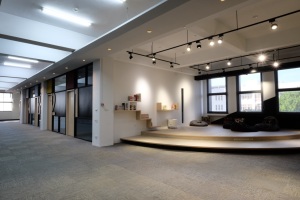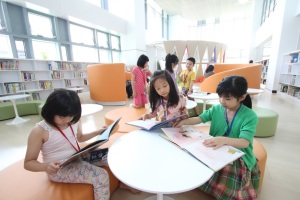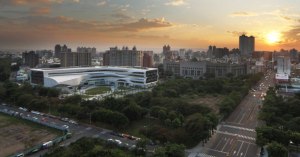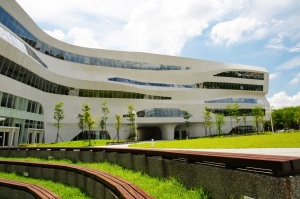
Name of the Library: Luking Library
Parent Organisation: Providence University
Street Address: Postal Address: 43301
Telephone : 886-4-26328001 ext. 11631(incl Country code)
Web Address: http://www.lib.pu.edu.tw/
Library Email: lukingmesg@lib.pu.edu.tw
Type of Library : Central/ Main
Population served: Providence University Community
Project Type: Conversion Refurbishment
Size (square metres): 21,931
Date of Completion: 1988, Extension: 2005, Conversion / Refurbishment: 2015
Architect:
Chen-Chen Tang (1987, 2005, Original and Extension Architect)
Meng-Chin Liu (2015, Conversion / Refurbishment

Description
History
In 1953, the Providence library was established on Fuhsing Road in Taichung, Taiwan. In 1964, it was officially named the Luking Library in honor of Mother Marie Gratia Luking, the founder of the college. In 1988, when the university relocated to its present site in Shalu, the library holdings were moved to a brand new building. In 2005 a major extension to the library was completed, and since then the library has undergone a major renovation of space which saw completion in 2015. Luking Library is now listed as one of The 10 Libraries You Must Visit in Taiwan.
Our Collection
The library holdings that amount to approximately 1,500,000 items include books, journals, newspapers, audio-visual materials and on-line resources. Books in English Literature, American Literature, and Children’s Literature are featured.
Space Design
The space in the Luking Library is based on a user-demand principle. The goal of this design is for library users to enjoy multiple ways of reading and self-study that will stimulate great ideas.
When you enter the library, the first place you notice is the Book Display Area. Here the library commonly places books grouped under special themes, including the nine subjects of the library archives, new arrivals, festivals, and current issues. Benches, couches, chairs are set under natural lighting so that users can comfortably spend their time in this area. Besides the traditional book exhibition, different brands of electronic tablets are available next to the Book Display Area for users to enjoy the fun of e-book reading and to experience the difference between reading on paper and reading on screens.
If one wants to find a good place to read throughout the library, there are many choices. From the First to the Fourth Floor, there are separate corners presenting the concepts of time, maze, writer’s corner and nostalgia. On the Third Floor, there is a nice, cozy open space for reading and relaxing, featuring bean bag chairs and several shelves with comics. The library is meant to be a friendly place for optimum use.
A learning commons is provided on the Second Floor and discussion rooms are located on the Third Floor. Both contain chairs, tables, and electronic equipment for patrons’ use. The offering of group study space in the library is one of many methods used to inspire and advance research, teaching, and life-long intellectual growth.
Finally, there is a comfortable new space on the Third Floor called the Reading Salon. With a high-ceiling design, it’s not only good for reading, but for holding events such as speeches by authors, movie appreciation, classical music performances, summer reading camps and Asian tea ceremonies to experience the art of living.

High-Quality Innovative Services
Our librarians also plan special events for library users. Through these activities, we hope that all users will learn to take advantage of all that the Luking Library has to offer.
At the beginning of each new semester, the library holds a “Teacher Appreciation Tea Ceremony” to emphasize the etiquette within the art of living. For regular activities such as “Read, and Think Differently” (Book思異), various artists, scholars and performers are invited to share their experiences with the audience. During summer vacation, a summer camp is offered to elementary school students from the countryside. The children spend three days and two nights in the library engaging in activities that focus on building their reading and writing skills.
The library also holds training sessions and workshops for its regular users and helps them to set the foundations for lifelong-learning. With a positive attitude toward all library users, we provide accurate and professional, immediate replies to all requests.
For more information about the library events please go to Luking Library FB fan page.
Awards, case studies, further information
- 2015 The 10 Libraries You Must Visit in Taiwan
- 2011 Cooperate with Hyweb Technology Co., Ltd. developing Library Automation system.
- 2010, 2013, 2014 Excellence in Interlibrary Loan Service of Interlibrary Cooperation Association
- 1991 Green Building Award








